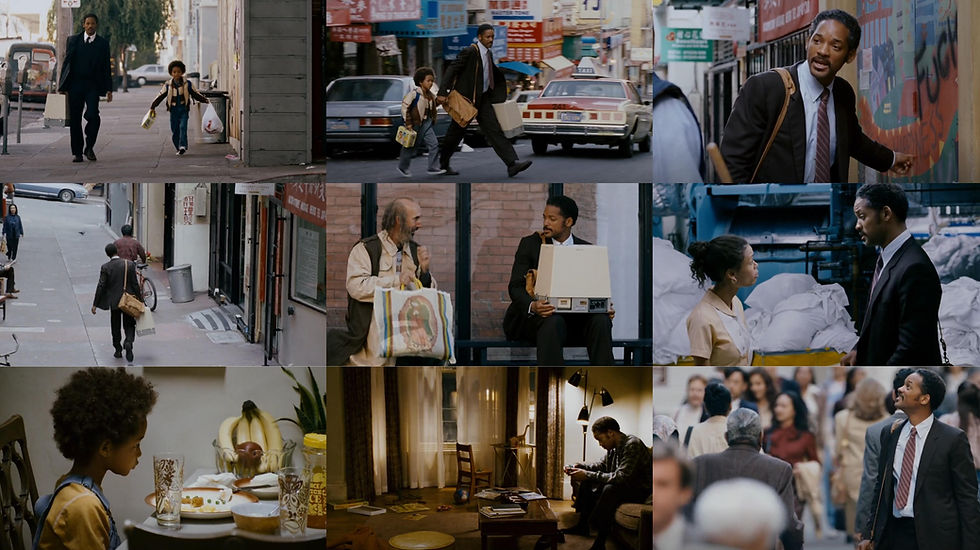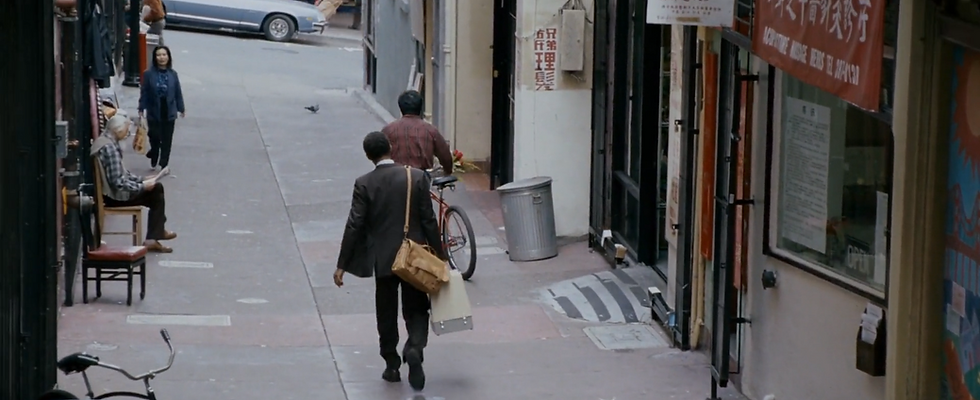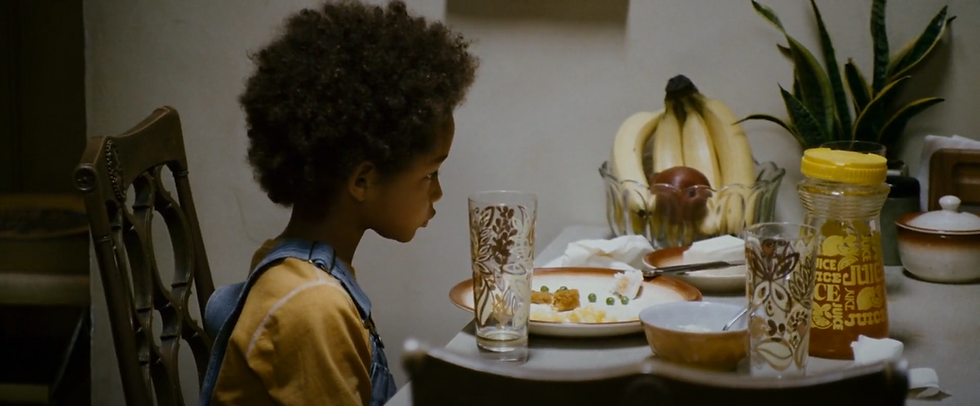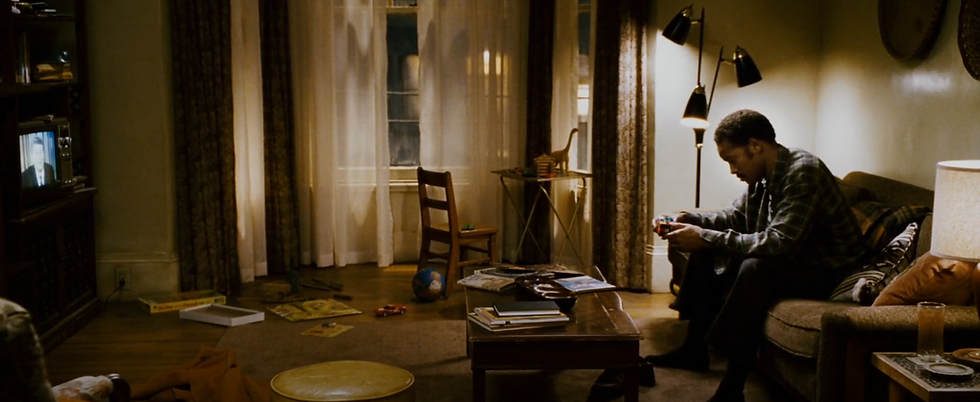The 9 Frame Analysis - The Pursuit of Happyness
- arijarslaan
- Oct 17, 2024
- 10 min read
Updated: Feb 24
Okay, so, The Pursuit of Happyness. Well, let me tell you, this film is not just an eye-watering movie, but a treat for the eyes. You might think it's some very dry film; nonetheless, the colors and shot composition are beautiful! Every frame feels like a ride with Chris Gardner—the main character.
9 frames I’m walking into:

First off, what's the deal with that "y" in Happyness? It looks like a typo, but it carries meaning. That's the point behind the "y": happiness is imperfect—messy, unpredictable, just like life. The film, in turn, asks at one point whether happiness is so hard to find and, therefore, should we be working so hard for it? This struggle in every scene lends the movie something precious. Alright, shall we jump in? Let's go!

1 - We see a shot of Chris walking with his son. The sun is out, it's not some beach kind of day, but you know, let's just make this little better, kind of thing, muted colors of the 'I'm fine face' everyone sports. The city is pretty trashy, litter everywhere and ancient autos. Chris is dressed in a three-piece suit declaring, 'I have been here for days.' Meanwhile, his son Christopher holds up this box of cereal like he was holding up a small pot of gold. How that dad moves- of course, cereal can be meal time and snack time both.
The camera uses a wide shot, showing them walking through city streets; it focuses on the environment and their distance from the busy world around them. The framing composition here emphasizes their isolation, positioning the characters at the edge of the frame while the rest of the city sprawls around them, symbolizing their emotional detachment from the chaotic world. We can soak up the space around us as we view this shot of the emotional weight the characters are carrying.
Chris walks, each heavy step as if it is a burden that lugs on his back to drag to the ground the struggles. His son carries cereal close to his chest; he follows his father along littered streets and the dust of the grimy city, not knowing how much weight his father carries on his shoulders. This shot of light, although natural, has deep shadows which remind us of how warm love in the father contrasts with the cold, unresponsive city surrounding him. There is always a difference between the real world of adulthood and the innocence of childhood, moving along as they are on the hard streets of this grim city. The depth of field is shallow, focusing on the characters while the blurred city around them suggests how distant they feel from the world they are walking through.

2 - We are, now, indeed in the busiest part of this town, almost Chinatown I guess. And Chris is not wearing that tattered suit which seems to me that he is concentrated: 'No good shoes to wear, I have dreams', he says- He is on his way into some kind of poor place with remnants of just some other shopping morning.
His boy does not need to look good; at least, at the moment his cereal is cool. The colors are vivid, life moving rapidly. The depth of field in this shot is shallow, framing Chris and his son while the busy background is softly blurred, placing emphasis on their isolation within this metropolis. It is looking down on the entire street scene from a high angle perspective. Chris and his son are tightly framed in the high-angle view, which contrasts with the expansive urban landscape, giving the impression that they are little and unimportant.
Here, the use of the high-angle shot is to emphasize how huge the city is to Chris and his son. It gives the audience a feeling of how small they are in the midst of this chaotic larger environment. The framing also captures the crowd as a dynamic force, almost overwhelming Chris and his son, as they navigate through it. They see them pushing their way through the crowd, again strengthening their fight as they try to cut through this busy, uncaring city.
The angle does a very good job to express how overwhelming their surrounding environment is, as though the city itself is towering over Chris, demanding that he meet the expectations. This visual emphasizes the weight of his journey but also serves to indicate his determination because he is moving forward irrespective of the odds. The colors of the vibrant street contrast with the muted tones of Chris’s suit, symbolizing his struggle to stand out amidst the overwhelming forces of the city.

3 - Now we stand before a graffiti alley, the state of confusion. Here, Chris stands in his full suit while representing the complete deterioration of his surrounding environment, the struggles he goes through inside being an epitome of an opposite scenario-when a man faces hard conditions from the outer world but manages to keep up the composed mask outside. The cereal box that the young boy is holding himself with could represent his attempt to find stability in the midst of the chaos.
The framing of this shot makes Chris the focal point, but the graffiti-laden walls surrounding him visually represent his messy life. Tight framing of Chris draws focus to his isolation despite being in a full-of-life environment. The bright colors of Chinatown contrast with the dull suit on Chris, focusing on the distinction between his exterior and the mess he is having inside. The natural yet asymmetrical lighting in this picture highlights Chris's hardship and the significance of his quest by creating harsh shadows on him. Chris's struggles on his way to fame are reflected in the street features, such as the graffiti, which provide levels of visual significance.
Chris's placement in the frame, encircled by the alley's debris, creates the impression that he is stuck in his current circumstance. The graffiti's vivid colors and erratic patterns represent the upheavals in his life, while his clinging to the cereal box conveys his intense optimism that things would improve. Shallow depth of field is applied for this shot in order to isolate Chris and his son by focusing on them and blurring out the overwhelming background. The shallow depth of field in this shot is also a reflection of Chris's focus on his goal, which makes him blind to the overwhelming situations.
The technical elements used to frame, color, and light the scene contribute to the intensity of the scene and its meaning.

4 - Imagine Chris with a bad back, carrying bills he can't afford, and strolling down a downtown street. Tall skyscrapers flank him on both his right and left as the camera takes a long shot of him from behind. This high-angle view visually represents the weight of his difficulties against the vastness of the town, making him look small in comparison to the towering towers. Because the audience is behind him and shares the weight of his crushing circumstances, the shot successfully conveys his sense of solitude.
The scene's suffocating tone and the gloomy color scheme both convey that Chris is having a difficult day. The suit he wears is symbolic of his effort to appear put together, but chaos brews underneath. The long shot with the high-angle perspective makes the idea that Chris is dwarfed by the city, which seems to engulf him from both sides.
This frame shows Chris completely isolated from all the previous busy city scenes. The environment reflects his inner separation, which actually depicts adulthood's truths: life's problems face one with all its issues alone, but the world advances.

5 - Chris is shown in this train scene sitting with his medical equipment by his side, a lifeline that represents both his emotional and physical hardships. Chris is seated next to a stranger, whose unpredictable and unnerving actions fuel his mounting uneasiness. Chris's facial expressions are highlighted by the close-up shot that the camera takes of the scene. His attempt to maintain composure in the face of the peculiar situation is gently conveyed by his look.
Technically speaking, it's a good close-up that emphasizes Chris's loneliness in the middle of a packed subway and focuses on his response to the circumstance. Chris is centered in the picture as the odd man invades his personal space, which heightens the tension because of the closeness. Additionally, Chris is isolated by the shallow depth of focus, and the blurred background keeps the viewer interested in the internal conflict he is experiencing. It's fairly harsh lighting. Overhead fluorescent lights are par for the subway course, unflatteringly casting shadows that make Chris's face look anything but welcoming in the scene. The contrast of lighting and colour between Chris' dark, subdued clothing and brighter, more colorful surroundings is like a visual representation of how disconnected Chris feels with the world outside.
Visually, the frame feels out of balance. The antics of the stranger sitting beside Chris are an annoying distraction, yet the camera does not provide an angle that suggests any other aspect of the shot, thus inflicting the feelings of tension and awkwardness upon the viewer. The spatial connection between the two characters is cramped and claustrophobic and makes the emotional discomfort more heightened. Chris's immobile position juxtaposed with the spasmodic motion of the stranger visually enhances the need for stability in Chris, who otherwise feels unstable. Color grading within this scene appears intentional and muted; it clashes quite starkly against the stranger's vibrancy of behavior. It lacks the warmth of the color, mirroring Chris's struggle inside, feeling exhausted and hopeless, like nothing around him was going to get any better or easier.

6 - Chris and his wife are fighting in this scenario, worn out from years of resentment. Chris appears to be emotionally weak and inferior since the camera is positioned close to his wife. Chris is positioned closer to the camera in the framing, creating a sense of tension, while his wife is farther away, demonstrating her emotional distance. Dark shadows surround her, weighing her down, and represent her internal struggle. Chris, illuminated with softer light, appears more vulnerable.
Their clothing is contrasting: Chris is in a suit, symbolizing being stuck, and his wife is more put together. Their emotional distance is reflected in their clothing. The conversation's serious tone is emphasized by the subdued color scheme. Their emotional loneliness is heightened by the subdued sound design and lack of background music, which heightens the suspense. The shot sequence in this scene highlights the distance between the two characters and graphically portrays the emotional strain they are both experiencing.

7 - There is a look of unease and disorientation about his presence at the dinner table, wide with age, puzzled and unfathomable. Dim lighting makes the scene tense, and it drags the weight off it. Framed shot probably a medium shot or wide shot with Christopher, centering him visually reflects his isolation. Lighting design underlines the emotion of the scene because it develops the inner fight within him portrayed in the dark shadows, making depth richer and advancing the mood.
The shot composition and character blocking subtly convey the tension between Christopher and his family. His uneasiness is heightened by the claustrophobic atmosphere produced by the tight framing and low camera position. The seriousness of the situation is communicated by Christopher's tense and guarded body language; perhaps, the tension will be relieved.
The setting's technical elements, such as the dramatic use of shadows and soft, diffused lighting, portray Christopher's internal conflict. His suit indicates further entrapment, and the heavy furniture and dark tones of set design mirror his helplessness. Shot sequences are constructed in such a way that both external conflict and internal wanting for peace are captured through this scene.

8 - Chris sits on the couch, trying to match the colors of the Rubik's Cube in his hands. The whole life can be symbolized as a cube with him: struggle to put all things together into one big work, but everything is wrong; he just cannot make it right. This dramatically heavy scene reveals the internal war of Chris-the failure to reach a decision and find the end. Soft warm lighting breaks up the tenseness of his surroundings, his faded t-shirt and sweatpants expressing the heaviness and severity of his fights. These small details reveal how life has affected a guy who has long sacrificed appearance.
Chris is positioned off-center in the picture, surrounded by strewn papers and broken cushions in a disorganized lounge. This mess serves as a visual representation of his life's turmoil. The muted colors of the space—grays, browns, and faded tones—evoke a sense of stagnation and despair, reinforcing the isolation Chris feels. The warm lighting contrasts with these colors, softening the harsh reality of his situation but also highlighting his sense of being trapped.
The camera moves in to see Chris's hands working on the Rubik's Cube and his anxious expression. As he tries to connect the dots, his anger grows. The close-up humanizes his suffering by capturing the internal battle he is going through. Finally, unable to figure it out, he looks at the cube in blankness. In a little but powerful gesture, Chris tosses the cube onto the couch to express his helplessness and resignation. In an effort to gain some clarity in the midst of the chaos, he rests his head back on the couch and allows the chaos of his surroundings to momentarily overtake him.

9 - In the final shot, Chris stands in front of the tall building, looking up at the huge structure. The warm sunlight brightens the scene, contrasting hope and uncertainty. The long shadows add depth, emphasizing the contrast between his current worries and the new opportunities ahead. What makes this work is the low-angle shot, which positions Chris beneath the enormous skyscraper, emphasizing the obstacles he must overcome in his quest for a better life.
Chris is preparing for the game by standing up and extending his arms. The rumpled suit symbolized his weary travel, showing wear and tear, how life could be taking upon him. There is a talk about his psychological battle; potential, but then doubt is apparent on his face. His being ordinary in simple attire against that grandeur represents the tension: who he now is and potential to be that much more significant.
The background features blurring pedestrians, speeding autos, and the busy city life. Here, the detachment is evident as life continues on its path; Chris is at a fork in the road, unsure of what to do. As he ventures into the unknown, the blur of the city symbolizes his loneliness and mental turmoil. His reflection is highlighted by the contrast between the chaos outside and the silence inside his head. The composition, lighting, and camera work all complement the character's emotional state, strengthening the story and symbolism of the movie.
CONCLUSION
And here is Chris Gardner's life story of twists and turns ups and downs and much cereal Each frame captures resilience and the messiness of happiness as a pursuit, rather than a goal. While we move through with Chris in his struggles we find ourselves rooting for the man wishing upon him the elusive "happyness" he's after.




Comments